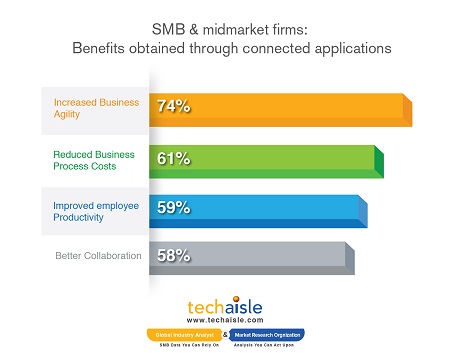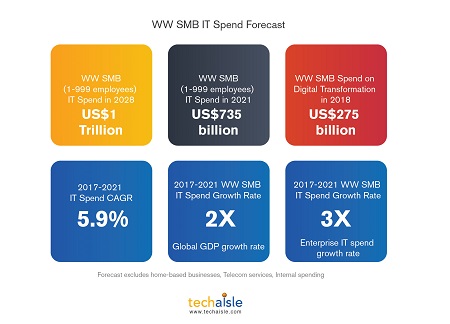“IT and cloud orchestration” reflects the reality of a multi-platform world in the era of digital transformation. Techaisle research shows that within the SMB & midmarket segment, orchestrated connected cloud and technology will be the focus of substantial new investment over the next few years. Connected cloud itself forms the basis for an Interwork platform for successful digital transformation and is crucial for competitiveness and growth.
- Upper midmarket firms use an average of 2.5 of the four leading public cloud providers (AWS, Microsoft, Google, IBM) – a true multi-cloud environment
- For 25% of small businesses and 51% of midmarket firms, workloads and data migrate across cloud and/or on-premise platforms
- 89% of midmarket firms state that orchestration tools are critical to their ability to deploy workloads on hybrid platforms
- 46% of SMBs do not know which cloud services to use and in what order
- 47% of SMB/midmarket-focused channel partners are offering orchestration but only 24% are delivering, but 55% are expecting substantial revenue increases in the next 1 year
- Use of orchestration is poised for growth as 40% of midmarket firms and 15% of small businesses are implementing cloud connectivity
Using a large number of on-premise technology as well as cloud platforms is escalating complexity beyond reasonable manual management limits. In response to this conundrum, many SMBs & midmarket firms are turning to orchestration as a strategy for optimizing use of multiple platforms and multiple technologies (topic of another blog another time). But help and guidance are missing. Even Techaisle’s latest channel partner study shows that although 47% offer orchestration but only 24% are delivering, and that also partially. Their vendor partners are not helping because of intense focus on enterprise segment.
In the quest for digitalization and digital transformation there has been ad hoc adoption of technology – both cloud & on-premise - as responses to paint points within SMBs.













